Razer BlackWidow Ultimate Keyboard Review
You can not even watch this post, if 10 years ago you did not have a “warm tube” keyboard with mechanical keys. But if you were and miss her - go under the cat, “warm up” =) However, I am almost sure that everyone had such a keyboard and I wouldn’t have to explain what her charm was. Therefore, under the cut - a review of a mechanical novelty.
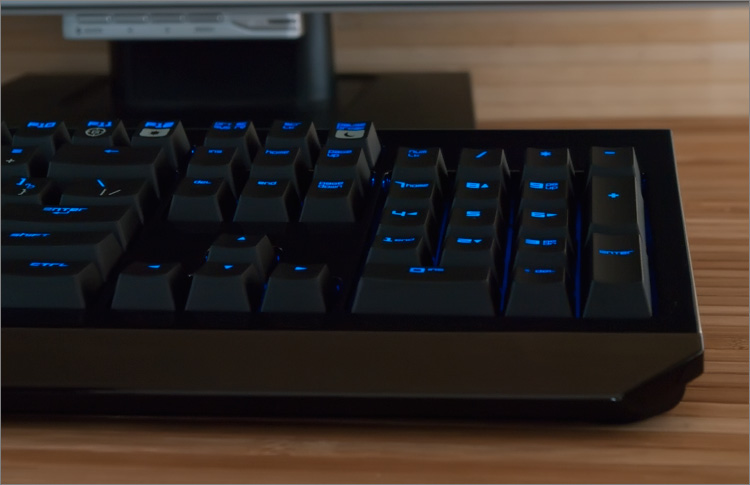
With a small bonus!
We have to admit that nowadays there are so many keyboards that you can buy “104 keys” almost in the union-press stall for change from “Sport-Express”. With any colors and shapes, sizes, materials and the number of buttons, with backlight, with screens, with touchpads and even with anti-bacterial impregnations - just pay. I don’t know about you, but I start yawning against the background of all this Chinese - I miss the times when everyone had the same keyboard and looked after them like cars. Perhaps it was for this that, as a sign of gratitude, the keyboards served for years, or even decades. But nowhere to go, time goes on and you need to adjust to it.
')
 In the hope of how to “ponozhaligirovat”, I decided to look for, is there something SUCH among modern devices. And, surprisingly, it did not take long to search - the gloomy Razer BlackWidow Ultimate almost immediately turned up under the arm. “Black widow”, a poisonous North American spider - in honor of the spiders, Razer traditionally names all its keyboards.
In the hope of how to “ponozhaligirovat”, I decided to look for, is there something SUCH among modern devices. And, surprisingly, it did not take long to search - the gloomy Razer BlackWidow Ultimate almost immediately turned up under the arm. “Black widow”, a poisonous North American spider - in honor of the spiders, Razer traditionally names all its keyboards.

The box is far from the largest (among those that I saw), but not a plastic bag. There is a slot through which one involuntarily wants to press the protruding arrow keys. The keyboard is covered inside with a plastic case: I had exactly the same mechanical position as my Mitsumi as a teenager - my parents forced each time to cover the keyboard so as not to get dusty =)
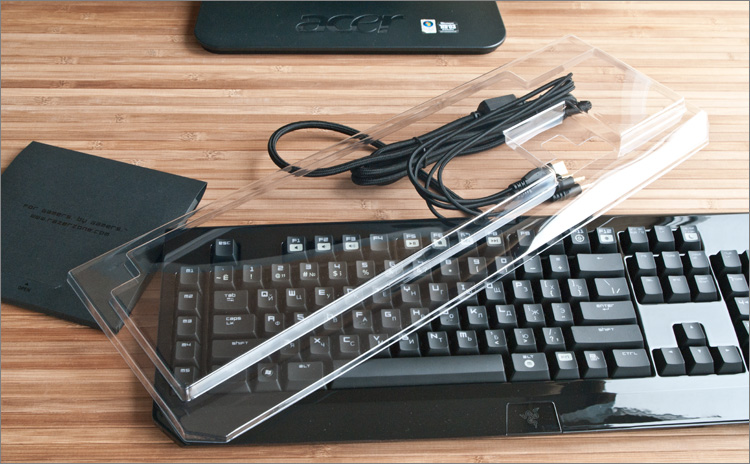
There is nothing unusual in the kit - a keyboard and some paper stickers:

First of all, attention is paid to the size of the keyboard - it is quite large and high compared to the usual "slims". Although the same Razer Arctosa is more tangible, not to mention any Lebedevsky “Optimus Maximus” (a long barge with keys). But there are advantages to this - the keyboard is monolithic, it does not bend - it stands still, like a monument.
After that, involuntarily attention is distracted by the glare on the glossy surface under the keys ... to be honest, I am very surprised that such a serious peripheral player uses gloss in such an everyday tool as the keyboard - Razer should be among the first to know where prints most like to hang out. But we have to admit that the gloss here is “noble” - it looks very impressive, like lacquered piano keys.
On the right side of the keyboard there are three connectors - one USB-port and two minijack (3.5mm): for headphones and microphone. They are not superfluous, but the location was chosen frankly not the most successful - considering that the majority of the population will have a mouse pad on the right.

Well, the last “amazing” thing in the design of this device is the cable coming from the middle of the far (from the user) side.
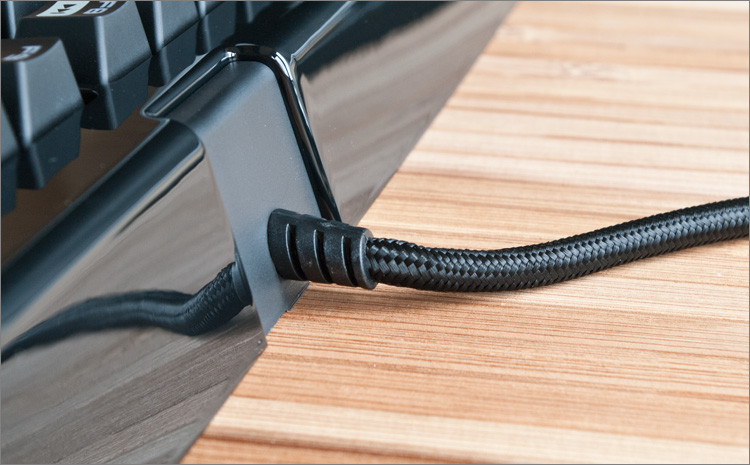
It is in a fabric braid, and at its end there are two USB connectors and two minijacks for connecting to an audio card. Everything is good, but it’s too thick — say, one “vein” for illuminating the keyboard keys, the second for connecting to a USB port, and two shielded cables for sound? Well, if only so;)

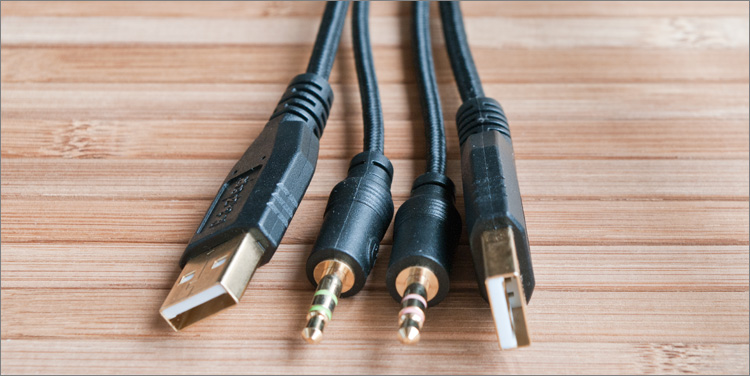
Now move to the keys. The layout of the keys is quite typical - the alphabetic block, the “correct” block of arrows, the numerical part. Big Shifty, flat Enter and big Backspace, no extra left slash - that's it! Plus, because they did not dangle the keyboard all sorts of multimedia junk.
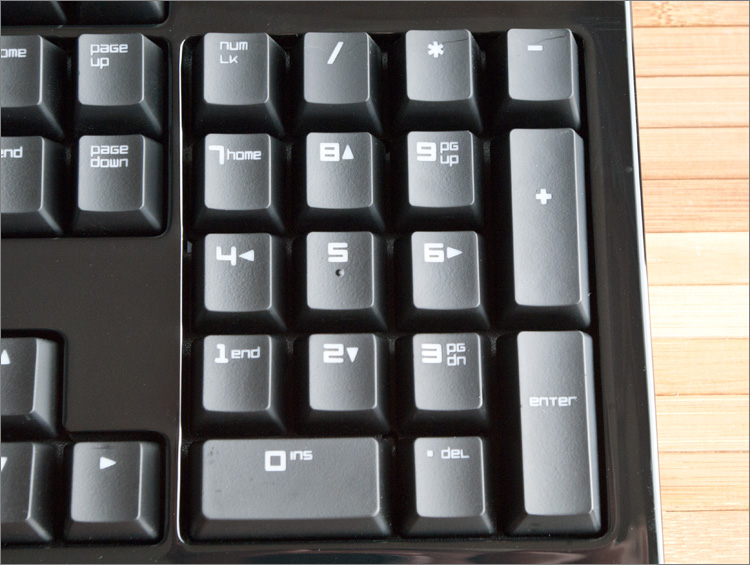
Keys custom size - a little narrower than usual. Typing is convenient, but at first the problems were with hotkeys - for example, the familiar “CTRL + S” finger combination on the old keyboard on this one will already be “CTRL + D”.
Not only are the key sizes unaccustomed, but also the distance from Esc to the first F-keys - if I used to press “CTRL + Shift + F5” in the email client to “Reply to all” in the letter, now I reach this combination with great difficulty. In general, it is not clear why this indent is - the company says, they say “optimized layout for games” - it may be convenient in some game, but you will definitely have to re-learn.
On the left there is a column of 5 programmable macro keys - a little further about them. Fn-button one - to the right of the space.
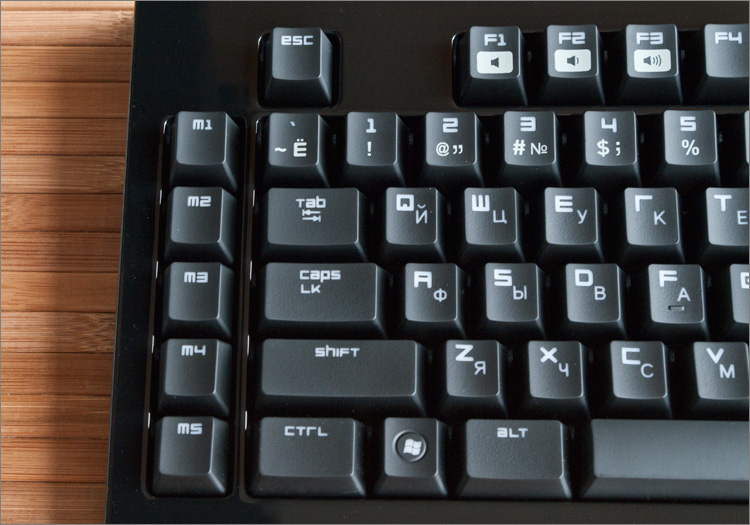
Fn-functions are mainly tied to the keys F1-F12 (not counting the right MacroAlt, which will also be discussed later) - this is the volume control, media player, backlight and the so-called game mode “GameMode”.
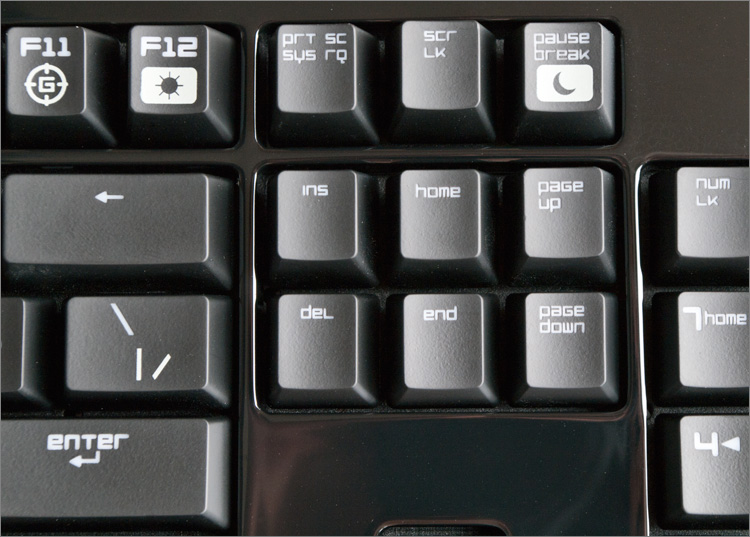
Of the features:
- The volume changes smoothly, but it lacks a visual indicator at least on the screen.
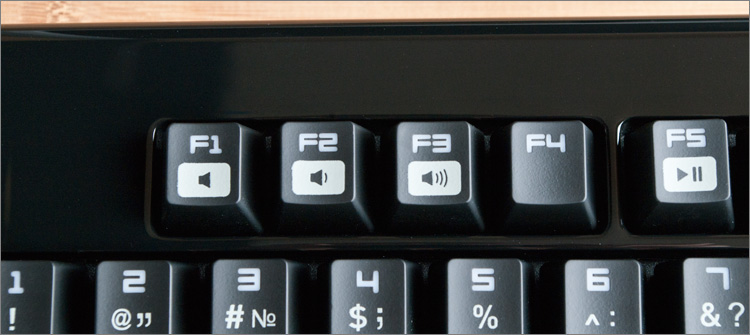
- Media player control buttons - I could not make friends with Winamp, but I didn’t really try - I’ve listened to music for a long time only from the network (where you don’t need media buttons, so you can easily reprogram them for something more useful). My work is hotkeys to open Skype, mailer and password manager).
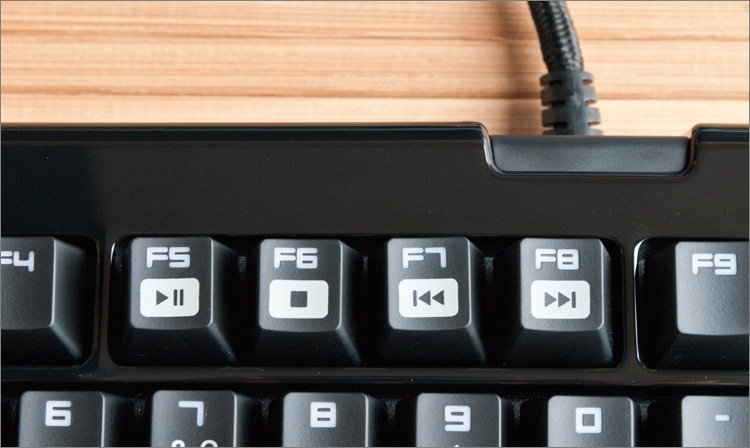
- GameMode (Fn + F11) - by and large only disables the Windows key so that it does not spoil the gaming experience) But this will not save from other “potential dangers” - for example, repeatedly pressing Shift, which activates the sticking of keys - those who fries with a fast and the furious in the NFS certainly faced this more than once.
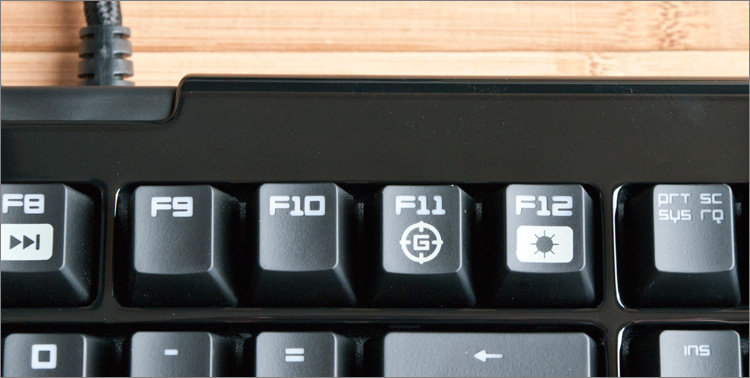
- Backlight (Fn + F12) - cyclic backlight control.
The backlighting is only blue-blue (the color was not transmitted in the photo) - another one cannot be chosen, unfortunately. In general, it is somewhat strange that for most of their gadgets, Razer chose the blue light - while green reigns in its logo (and on the site as a whole).

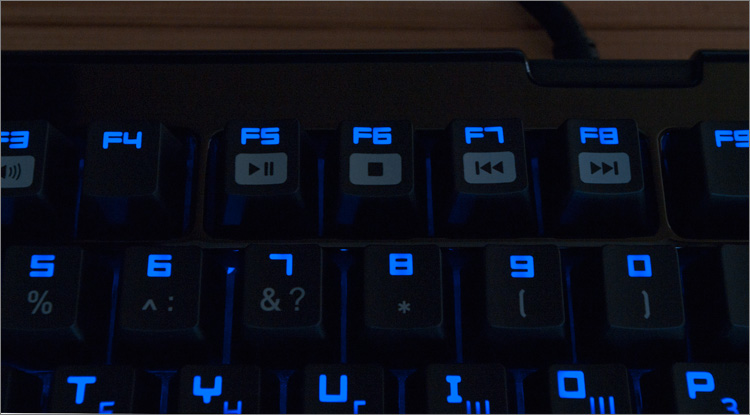
The backlight has 5 modes of operation - disabled, three gradations in ascending order (even the “lowest” shines quite brightly) and pulsating. I have a keyboard from the official Russian delivery (which is indicated by a sticker on the box), so Russian letters are also highlighted (although on some keyboards, Cyrillic letters are simply painted). But for some reason, special characters are not highlighted (passwords will be more difficult to enter) on numbers and Fn-actions. Special thanks to the Fn-button - due to the lack of backlighting, it is easy to find in the dark among the other buttons.
And finally - the font on the keys. For English letters and numbers, the original Razer font is used, which at first is somewhat unusual (for example, G is written instead of R, etc.); Cyrillic characters are the most common.
For the full operation of the device from the network you need to download the driver. Installation takes a minute - after that an icon appears in the tray. Click and see that in the window that appears there is nothing complicated. We move the cursors on the buttons and see a nice animation - in fact, everything here is not just beautiful, but also functional: the effect of any key can be changed.
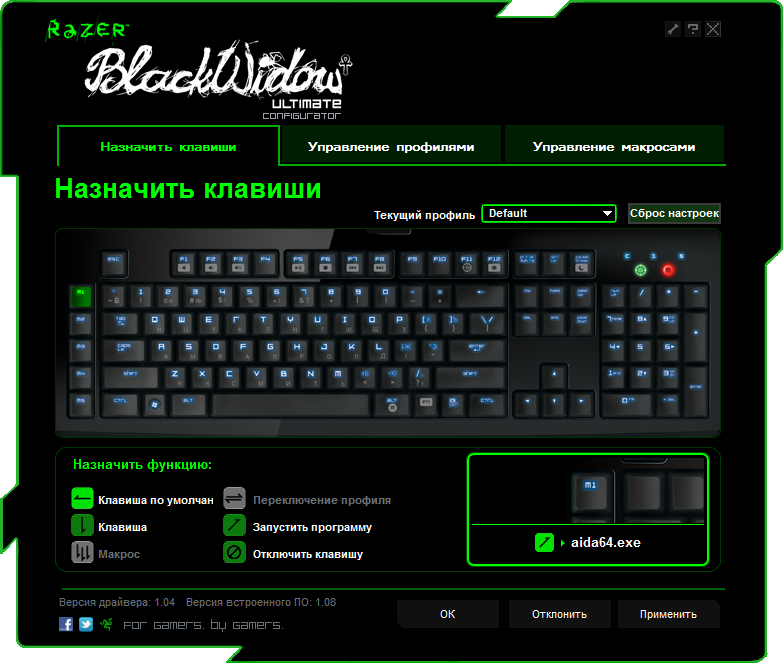
Keyboard software supports profiles - you can create them manually and link them to any game or application. The thing is simple, but very useful (if you first, as it should, set up). For example, in the near (2009 like) year a toy like BLUR came out on a PC. Arcade racing, flavored with aggressive PowerUp'ami - fun and colorful mess. All anything, but the control settings there look like this: two profiles for the keyboard, two profiles for the x-box gamepad ... and that's it. Well, if at least one keyboard layout was normal - they were both so disgusting that it was not clear what genius they were at all. If BlackWindow Ultimate were (however, now you can play the game), it would be much easier - write down which button is responsible for what, open the keyboard profiles and create a new one. We select the application, register the autorun, go to the tab with the settings of the keyboard buttons and assign the control as we like (you can reassign any key). And so you can do absolutely with any game or application - how to be the owners of conventional keyboards is not clear.
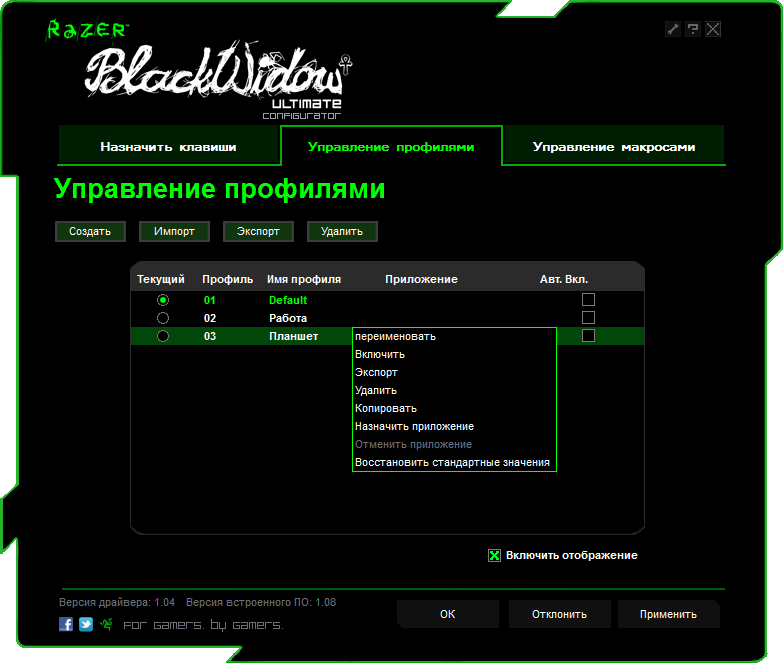
To switch between profiles, you can use as many as 4 ways:
1) Fn key + digit from 1-9 and 0 (but not on the numeric keypad)
2) Via keyboard driver
3) Autoswitching (by application)
4) By programming the button on the profile
You can configure any key (except Fn) - in addition to the bind and default settings, you can simply turn off any of the buttons.
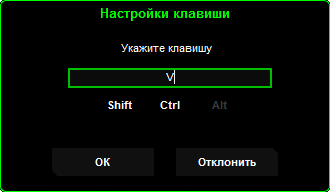
Sorry, there is no poppy at hand - it would be interesting to try to hang CTRL on CMD, on CMD - Alt, and on Alt - CTRL =)
Another useful thing :) I first met this “phenomenon” a long time ago in Photoshop, when I created Action for routine work. Conveniently - I wrote down the necessary (any) sequence of actions, tied it to a button and that's it - you press one button and the computer does everything for you. The same with the keyboard - go to the settings page (in the macros) and create the desired combination - you can attach the result to any of the buttons in the leftmost column (there are only five buttons - it may not seem enough to someone, but I’m on the contrary happy that there is nothing superfluous). Everything is set up - combinations, delays between clicks, something else there ... =) It’s a pity that you can’t add additional actions to the buttons due to modifier keys (for example, Macro + Alt) - I hope this will add in the future.

You can record a macro right in the game, “on the go” - using the Fn + MacroAlt combination. But this method has one drawback - the delay between keystrokes will be the same as it was when recording, that is, it will not be possible to speed up the execution, for example - you can edit delays only through the profiler.
Now about the sensations directly from the work on the keyboard. Once again I remind you: we are dealing with thoroughbred mechanics, which means that the tactile sensations from typing are not just different from ordinary keyboards - they (the differences) are enormous. Well, yes, the keys are pressed in this new. The point is exactly how they are pressed. The finger touches the surface of the key (it is made of very high-quality, tactilely pleasant matte plastic; then there is an elastic pressure, the force of which gradually increases (up to 50 grams - the ideal value - if you put a relaxed hand on the keyboard, then no key will press) You can feel it, because the key travel is quite large. And then a muffled click is heard, and a new symbol appears on the screen at lightning speed. But the pleasure does not end here - a quick but rather smooth rise of the finger follows. . And upstairs That's all I described when I pressed the button very slowly, so that you can make out what is happening on the stage - the normal printing pleasure for each printed character, and all together it turns into a kinesthetic paradise - in my opinion, it is called =)

Even this sound when typing ... you would have given a lot for this =) In the lively correspondence, the clattering sounds like the clang of the automaton ... well, okay, not the automaton ... but at least a mannequin typewriter - everyone pays attention to the sound, but nobody says “hey let it be quiet there ”- on the contrary -“ you are speeding something! ”. Accidental keystrokes are practically excluded - you always know if a key was pressed or not.
UltraPooling technology allows you to poll the keyboard port a thousand times per second - the monitor is more likely to update the frame more slowly than the computer will receive information that the key has been pressed. If you have never encountered such a thing, you should just try it once.
On the official website, this keyboard can be bought for 5170 rubles.
In order not to create a separate post, I decided at the same time to tell you about another “gemeyrsky” gadget, which very harmoniously sat down near the keyboard. No, this is not a mouse, as you probably thought - talking about portable speakers Razer Ferox .
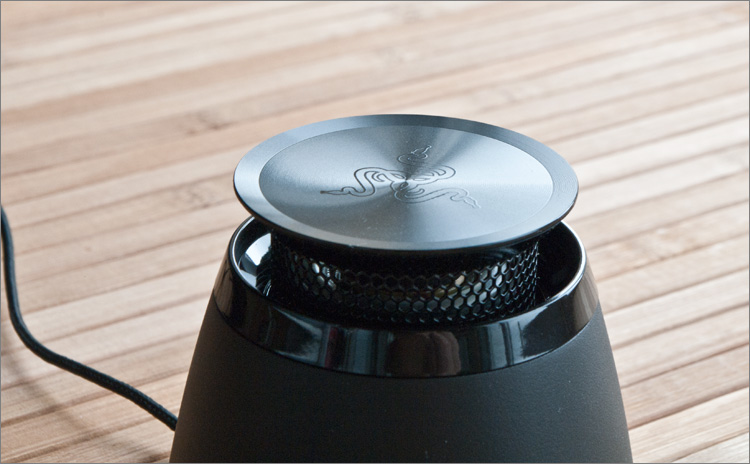
Two small columns in the shape of a truncated cone - in addition to them in the box there is only a wire and a cover. They play 360 degrees around themselves, that is, the sound is not as directed as that of the “traditional” speakers. This is convenient - you can play around with the location of the speakers without much damage to the sound quality.

If you click on the upper plane of the column, it will rise about a centimeter - under the metal “roof” you will see a decorative mesh. Everything, the column is turned on and ready to work - we “raise” the second one and we can start listening. Accordingly, clicking on the speakers, the sound disappears - a kind of mute (much more convenient than finding the right button on the keyboard. A side effect - everyone tries to go up and click on the speakers :) Unfortunately, there is no volume control.
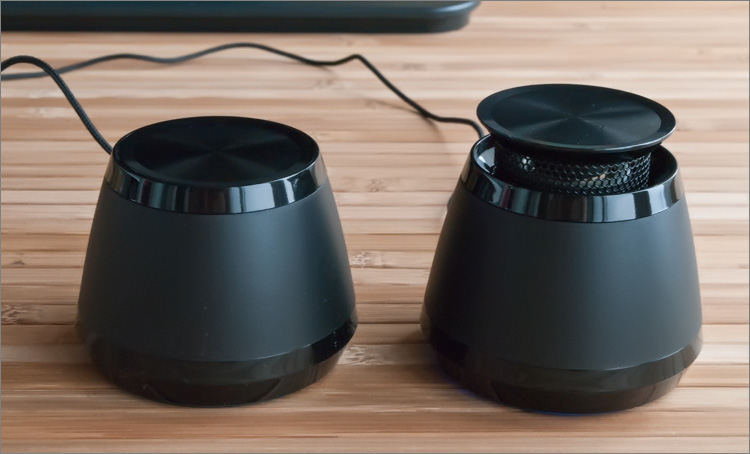
At least they are small and format 2.0 (that is, without a separate subwoofer), but the bass is also present - as the company claims, due to the expandable resonant camera: the result is something like 2.1, only without the subwoofer =)
Another advantage of the speakers is that they have a built-in battery, which lasts for 12 hours of battery life (you can take the speakers with you and listen to music away from civilization). The speakers have a functional backlight - it is lit in blue, but if suddenly the battery is discharged, then it changes to red. When working from a usb port, it pulses mysteriously - not that it is a direct, bewitching sight, as they say in press releases, but it looks nice. At least in other inexpensive columns there is no such beauty.

The wire from the sound source to the speaker is H-shaped. On the one hand, there are two miniUSB connectors for connecting to speakers, on the other hand, USB (for charging, if necessary) and mini jack (for connecting to the sound source). The miniUSB connectors bear the letters L and R (to distinguish the speakers), but they can only be seen until the wires are inserted into the connectors - respectively, sticking the wires, it is already unclear where the right speaker is and where the left speaker is (only if by sound). But the biggest drawback of the wire is its length - it is clear that they fought for portable properties and everything ... but it turned out that I don’t have enough wire to the system man who stands on the table, but simply “lengthen” it with improvised means — it is necessary to extend two wires at once. If only they could put in a pair of wiring.
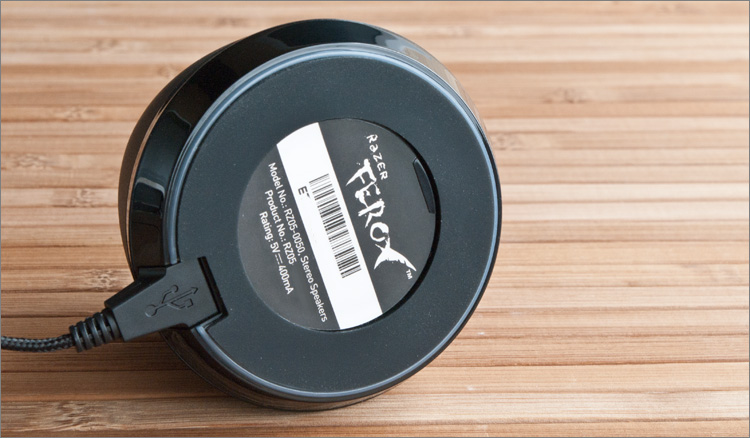
The only unpleasant aftertaste (maybe this is a feature of my specimen) - when you connect the speakers directly to the keyboard (to the USB port and mini-jack), the speakers begin to fade, but only at some levels of the backlight turned on (when turned off and at the maximum, they do not fade). Confirmation of this was the mode of pulsating backlighting of the keys, because of which the artifacts pulsed in the same way. I came to this empirically and while the backlight preferred a convenient location of the speakers.
Otherwise, if we deny these two deficiencies found, the speakers are damn good for their size. The slogan “Tiny but mighty” is on the box, which can be interpreted as “small and distant” - Ferox really plays very loudly and beautifully, without too much “bubine” and other artifacts peculiar to low-cost devices. I didn’t take it with me on the road yet — I use it at work so that there is a good sound at no extra cost.
The cost of the columns on the official website is 2490 rubles, although on Yandex.Market the price tag starts from 2000 rubles - in any case, this is relatively little for this class of devices (if you do not take into account noname-tweeters).
You don't buy a keyboard for the sake of macros and a beautiful font on the keys - you need to print for it. Therefore, if we take the convenience of typing and tactile sensations as the main criteria, then they are beyond praise. Game properties may give some tactical advantages, but the player of me is so-so - sometimes I shake old times, no championships;) Everything else is not so important for me, but I can’t say anything bad either: lights, software is all on the level.
As for the columns, there are some shortcomings in addition to the advantages, but it is easy to put up with them. So far, too, pleased, but how much they will work and how - time will tell =)

With a small bonus!
We have to admit that nowadays there are so many keyboards that you can buy “104 keys” almost in the union-press stall for change from “Sport-Express”. With any colors and shapes, sizes, materials and the number of buttons, with backlight, with screens, with touchpads and even with anti-bacterial impregnations - just pay. I don’t know about you, but I start yawning against the background of all this Chinese - I miss the times when everyone had the same keyboard and looked after them like cars. Perhaps it was for this that, as a sign of gratitude, the keyboards served for years, or even decades. But nowhere to go, time goes on and you need to adjust to it.
')
 In the hope of how to “ponozhaligirovat”, I decided to look for, is there something SUCH among modern devices. And, surprisingly, it did not take long to search - the gloomy Razer BlackWidow Ultimate almost immediately turned up under the arm. “Black widow”, a poisonous North American spider - in honor of the spiders, Razer traditionally names all its keyboards.
In the hope of how to “ponozhaligirovat”, I decided to look for, is there something SUCH among modern devices. And, surprisingly, it did not take long to search - the gloomy Razer BlackWidow Ultimate almost immediately turned up under the arm. “Black widow”, a poisonous North American spider - in honor of the spiders, Razer traditionally names all its keyboards.
The box is far from the largest (among those that I saw), but not a plastic bag. There is a slot through which one involuntarily wants to press the protruding arrow keys. The keyboard is covered inside with a plastic case: I had exactly the same mechanical position as my Mitsumi as a teenager - my parents forced each time to cover the keyboard so as not to get dusty =)

There is nothing unusual in the kit - a keyboard and some paper stickers:

First of all, attention is paid to the size of the keyboard - it is quite large and high compared to the usual "slims". Although the same Razer Arctosa is more tangible, not to mention any Lebedevsky “Optimus Maximus” (a long barge with keys). But there are advantages to this - the keyboard is monolithic, it does not bend - it stands still, like a monument.
After that, involuntarily attention is distracted by the glare on the glossy surface under the keys ... to be honest, I am very surprised that such a serious peripheral player uses gloss in such an everyday tool as the keyboard - Razer should be among the first to know where prints most like to hang out. But we have to admit that the gloss here is “noble” - it looks very impressive, like lacquered piano keys.
On the right side of the keyboard there are three connectors - one USB-port and two minijack (3.5mm): for headphones and microphone. They are not superfluous, but the location was chosen frankly not the most successful - considering that the majority of the population will have a mouse pad on the right.

Well, the last “amazing” thing in the design of this device is the cable coming from the middle of the far (from the user) side.

It is in a fabric braid, and at its end there are two USB connectors and two minijacks for connecting to an audio card. Everything is good, but it’s too thick — say, one “vein” for illuminating the keyboard keys, the second for connecting to a USB port, and two shielded cables for sound? Well, if only so;)


Now move to the keys. The layout of the keys is quite typical - the alphabetic block, the “correct” block of arrows, the numerical part. Big Shifty, flat Enter and big Backspace, no extra left slash - that's it! Plus, because they did not dangle the keyboard all sorts of multimedia junk.

Keys custom size - a little narrower than usual. Typing is convenient, but at first the problems were with hotkeys - for example, the familiar “CTRL + S” finger combination on the old keyboard on this one will already be “CTRL + D”.
Not only are the key sizes unaccustomed, but also the distance from Esc to the first F-keys - if I used to press “CTRL + Shift + F5” in the email client to “Reply to all” in the letter, now I reach this combination with great difficulty. In general, it is not clear why this indent is - the company says, they say “optimized layout for games” - it may be convenient in some game, but you will definitely have to re-learn.
On the left there is a column of 5 programmable macro keys - a little further about them. Fn-button one - to the right of the space.

Fn-functions are mainly tied to the keys F1-F12 (not counting the right MacroAlt, which will also be discussed later) - this is the volume control, media player, backlight and the so-called game mode “GameMode”.

Of the features:
- The volume changes smoothly, but it lacks a visual indicator at least on the screen.

- Media player control buttons - I could not make friends with Winamp, but I didn’t really try - I’ve listened to music for a long time only from the network (where you don’t need media buttons, so you can easily reprogram them for something more useful). My work is hotkeys to open Skype, mailer and password manager).

- GameMode (Fn + F11) - by and large only disables the Windows key so that it does not spoil the gaming experience) But this will not save from other “potential dangers” - for example, repeatedly pressing Shift, which activates the sticking of keys - those who fries with a fast and the furious in the NFS certainly faced this more than once.

- Backlight (Fn + F12) - cyclic backlight control.
The backlighting is only blue-blue (the color was not transmitted in the photo) - another one cannot be chosen, unfortunately. In general, it is somewhat strange that for most of their gadgets, Razer chose the blue light - while green reigns in its logo (and on the site as a whole).


The backlight has 5 modes of operation - disabled, three gradations in ascending order (even the “lowest” shines quite brightly) and pulsating. I have a keyboard from the official Russian delivery (which is indicated by a sticker on the box), so Russian letters are also highlighted (although on some keyboards, Cyrillic letters are simply painted). But for some reason, special characters are not highlighted (passwords will be more difficult to enter) on numbers and Fn-actions. Special thanks to the Fn-button - due to the lack of backlighting, it is easy to find in the dark among the other buttons.
And finally - the font on the keys. For English letters and numbers, the original Razer font is used, which at first is somewhat unusual (for example, G is written instead of R, etc.); Cyrillic characters are the most common.
Software
For the full operation of the device from the network you need to download the driver. Installation takes a minute - after that an icon appears in the tray. Click and see that in the window that appears there is nothing complicated. We move the cursors on the buttons and see a nice animation - in fact, everything here is not just beautiful, but also functional: the effect of any key can be changed.

Keyboard software supports profiles - you can create them manually and link them to any game or application. The thing is simple, but very useful (if you first, as it should, set up). For example, in the near (2009 like) year a toy like BLUR came out on a PC. Arcade racing, flavored with aggressive PowerUp'ami - fun and colorful mess. All anything, but the control settings there look like this: two profiles for the keyboard, two profiles for the x-box gamepad ... and that's it. Well, if at least one keyboard layout was normal - they were both so disgusting that it was not clear what genius they were at all. If BlackWindow Ultimate were (however, now you can play the game), it would be much easier - write down which button is responsible for what, open the keyboard profiles and create a new one. We select the application, register the autorun, go to the tab with the settings of the keyboard buttons and assign the control as we like (you can reassign any key). And so you can do absolutely with any game or application - how to be the owners of conventional keyboards is not clear.

To switch between profiles, you can use as many as 4 ways:
1) Fn key + digit from 1-9 and 0 (but not on the numeric keypad)
2) Via keyboard driver
3) Autoswitching (by application)
4) By programming the button on the profile
You can configure any key (except Fn) - in addition to the bind and default settings, you can simply turn off any of the buttons.

Sorry, there is no poppy at hand - it would be interesting to try to hang CTRL on CMD, on CMD - Alt, and on Alt - CTRL =)
Macros
Another useful thing :) I first met this “phenomenon” a long time ago in Photoshop, when I created Action for routine work. Conveniently - I wrote down the necessary (any) sequence of actions, tied it to a button and that's it - you press one button and the computer does everything for you. The same with the keyboard - go to the settings page (in the macros) and create the desired combination - you can attach the result to any of the buttons in the leftmost column (there are only five buttons - it may not seem enough to someone, but I’m on the contrary happy that there is nothing superfluous). Everything is set up - combinations, delays between clicks, something else there ... =) It’s a pity that you can’t add additional actions to the buttons due to modifier keys (for example, Macro + Alt) - I hope this will add in the future.

You can record a macro right in the game, “on the go” - using the Fn + MacroAlt combination. But this method has one drawback - the delay between keystrokes will be the same as it was when recording, that is, it will not be possible to speed up the execution, for example - you can edit delays only through the profiler.
Keyboard Impressions
Now about the sensations directly from the work on the keyboard. Once again I remind you: we are dealing with thoroughbred mechanics, which means that the tactile sensations from typing are not just different from ordinary keyboards - they (the differences) are enormous. Well, yes, the keys are pressed in this new. The point is exactly how they are pressed. The finger touches the surface of the key (it is made of very high-quality, tactilely pleasant matte plastic; then there is an elastic pressure, the force of which gradually increases (up to 50 grams - the ideal value - if you put a relaxed hand on the keyboard, then no key will press) You can feel it, because the key travel is quite large. And then a muffled click is heard, and a new symbol appears on the screen at lightning speed. But the pleasure does not end here - a quick but rather smooth rise of the finger follows. . And upstairs That's all I described when I pressed the button very slowly, so that you can make out what is happening on the stage - the normal printing pleasure for each printed character, and all together it turns into a kinesthetic paradise - in my opinion, it is called =)

Even this sound when typing ... you would have given a lot for this =) In the lively correspondence, the clattering sounds like the clang of the automaton ... well, okay, not the automaton ... but at least a mannequin typewriter - everyone pays attention to the sound, but nobody says “hey let it be quiet there ”- on the contrary -“ you are speeding something! ”. Accidental keystrokes are practically excluded - you always know if a key was pressed or not.
UltraPooling technology allows you to poll the keyboard port a thousand times per second - the monitor is more likely to update the frame more slowly than the computer will receive information that the key has been pressed. If you have never encountered such a thing, you should just try it once.
Specifications Razer BlackWidow Ultimate
- Fully mechanical keys with a pressing force of 50 g
- Individual key backlighting with 5 levels of brightness
- Full illumination of Russian letters
- Poll Frequency 1000 Hz Ultrapolling ™ / Response Time 1 ms
- Fully programmable keys with on-the-fly macro recording
- Game mode with disabling the Windows key
- 10 customizable software profiles with switching on the fly
- 5 additional macro keys
- Optimized for gaming key layout to minimize accidental keystrokes
- Easy access to media keys.
- Cable in fabric braid
- Headphone and microphone jacks
- Additional USB port
- Dimensions: 475 x 171 x 30 mm
- Weight: 1.5 kg
System requirements
- PC with USB port
- Windows® 7 / Windows Vista® / Windows® XP
- Internet connection (for installing drivers)
- 35MB of free hard disk space
Specifications
- Fully mechanical keys with a pressing force of 50 g
- Individual key backlighting with 5 levels of brightness
- Full illumination of Russian letters
- Poll Frequency 1000 Hz Ultrapolling ™ / Response Time 1 ms
- Fully programmable keys with on-the-fly macro recording
- Game mode with disabling the Windows key
- 10 customizable software profiles with switching on the fly
- 5 additional macro keys
- Optimized for gaming key layout to minimize accidental keystrokes
- Easy access to media keys.
- Cable in fabric braid
- Headphone and microphone jacks
- Additional USB port
- Dimensions: 475 x 171 x 30 mm
- Weight: 1.5 kg
System requirements
- PC with USB port
- Windows® 7 / Windows Vista® / Windows® XP
- Internet connection (for installing drivers)
- 35MB of free hard disk space
On the official website, this keyboard can be bought for 5170 rubles.
▌ Razer Ferox
In order not to create a separate post, I decided at the same time to tell you about another “gemeyrsky” gadget, which very harmoniously sat down near the keyboard. No, this is not a mouse, as you probably thought - talking about portable speakers Razer Ferox .

Two small columns in the shape of a truncated cone - in addition to them in the box there is only a wire and a cover. They play 360 degrees around themselves, that is, the sound is not as directed as that of the “traditional” speakers. This is convenient - you can play around with the location of the speakers without much damage to the sound quality.

If you click on the upper plane of the column, it will rise about a centimeter - under the metal “roof” you will see a decorative mesh. Everything, the column is turned on and ready to work - we “raise” the second one and we can start listening. Accordingly, clicking on the speakers, the sound disappears - a kind of mute (much more convenient than finding the right button on the keyboard. A side effect - everyone tries to go up and click on the speakers :) Unfortunately, there is no volume control.

At least they are small and format 2.0 (that is, without a separate subwoofer), but the bass is also present - as the company claims, due to the expandable resonant camera: the result is something like 2.1, only without the subwoofer =)
Another advantage of the speakers is that they have a built-in battery, which lasts for 12 hours of battery life (you can take the speakers with you and listen to music away from civilization). The speakers have a functional backlight - it is lit in blue, but if suddenly the battery is discharged, then it changes to red. When working from a usb port, it pulses mysteriously - not that it is a direct, bewitching sight, as they say in press releases, but it looks nice. At least in other inexpensive columns there is no such beauty.

The wire from the sound source to the speaker is H-shaped. On the one hand, there are two miniUSB connectors for connecting to speakers, on the other hand, USB (for charging, if necessary) and mini jack (for connecting to the sound source). The miniUSB connectors bear the letters L and R (to distinguish the speakers), but they can only be seen until the wires are inserted into the connectors - respectively, sticking the wires, it is already unclear where the right speaker is and where the left speaker is (only if by sound). But the biggest drawback of the wire is its length - it is clear that they fought for portable properties and everything ... but it turned out that I don’t have enough wire to the system man who stands on the table, but simply “lengthen” it with improvised means — it is necessary to extend two wires at once. If only they could put in a pair of wiring.

The only unpleasant aftertaste (maybe this is a feature of my specimen) - when you connect the speakers directly to the keyboard (to the USB port and mini-jack), the speakers begin to fade, but only at some levels of the backlight turned on (when turned off and at the maximum, they do not fade). Confirmation of this was the mode of pulsating backlighting of the keys, because of which the artifacts pulsed in the same way. I came to this empirically and while the backlight preferred a convenient location of the speakers.
Otherwise, if we deny these two deficiencies found, the speakers are damn good for their size. The slogan “Tiny but mighty” is on the box, which can be interpreted as “small and distant” - Ferox really plays very loudly and beautifully, without too much “bubine” and other artifacts peculiar to low-cost devices. I didn’t take it with me on the road yet — I use it at work so that there is a good sound at no extra cost.
Specifications Razer Ferox
Output power: 2 x 3 W
Frequency range: 150 to 20,000 Hz
Speakers: 30 mm, neodymium magnetic
Interfaces: 3.5 mm audio jack & USB
Battery capacity: 470mAh, up to 12 hours of operation
Optional: LED indicator of battery charge status, carrying case included
Dimensions: 70 x 70 x 53 - 64 mm
Specifications
Output power: 2 x 3 W
Frequency range: 150 to 20,000 Hz
Speakers: 30 mm, neodymium magnetic
Interfaces: 3.5 mm audio jack & USB
Battery capacity: 470mAh, up to 12 hours of operation
Optional: LED indicator of battery charge status, carrying case included
Dimensions: 70 x 70 x 53 - 64 mm
The cost of the columns on the official website is 2490 rubles, although on Yandex.Market the price tag starts from 2000 rubles - in any case, this is relatively little for this class of devices (if you do not take into account noname-tweeters).
Instead of output
You don't buy a keyboard for the sake of macros and a beautiful font on the keys - you need to print for it. Therefore, if we take the convenience of typing and tactile sensations as the main criteria, then they are beyond praise. Game properties may give some tactical advantages, but the player of me is so-so - sometimes I shake old times, no championships;) Everything else is not so important for me, but I can’t say anything bad either: lights, software is all on the level.
As for the columns, there are some shortcomings in addition to the advantages, but it is easy to put up with them. So far, too, pleased, but how much they will work and how - time will tell =)
Source: https://habr.com/ru/post/142875/
All Articles